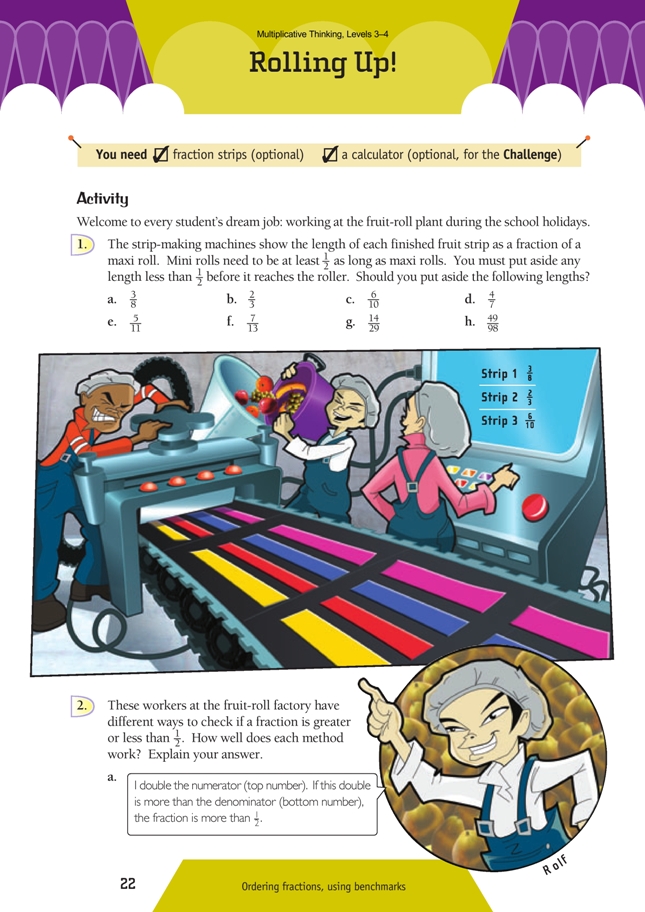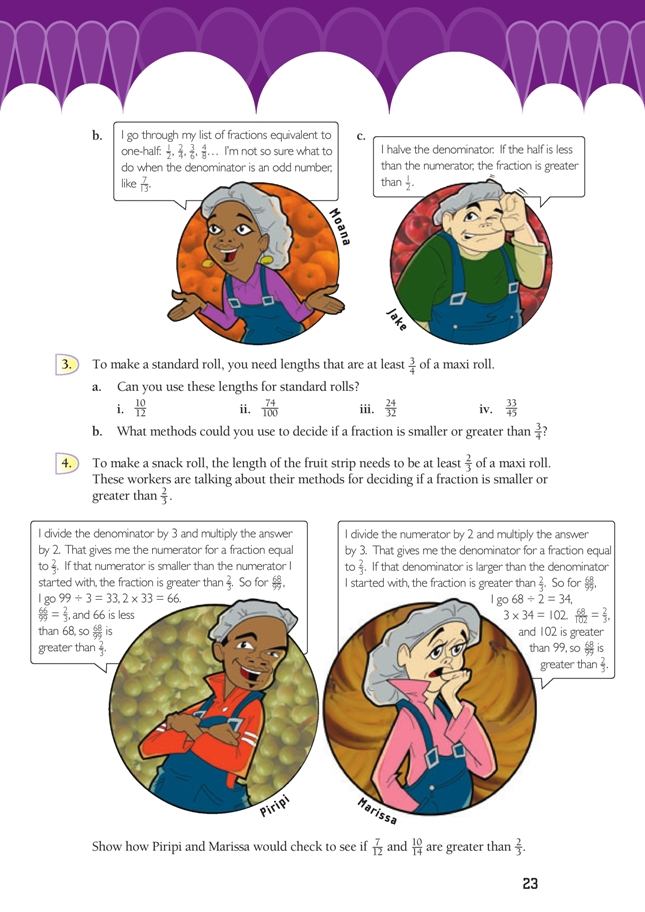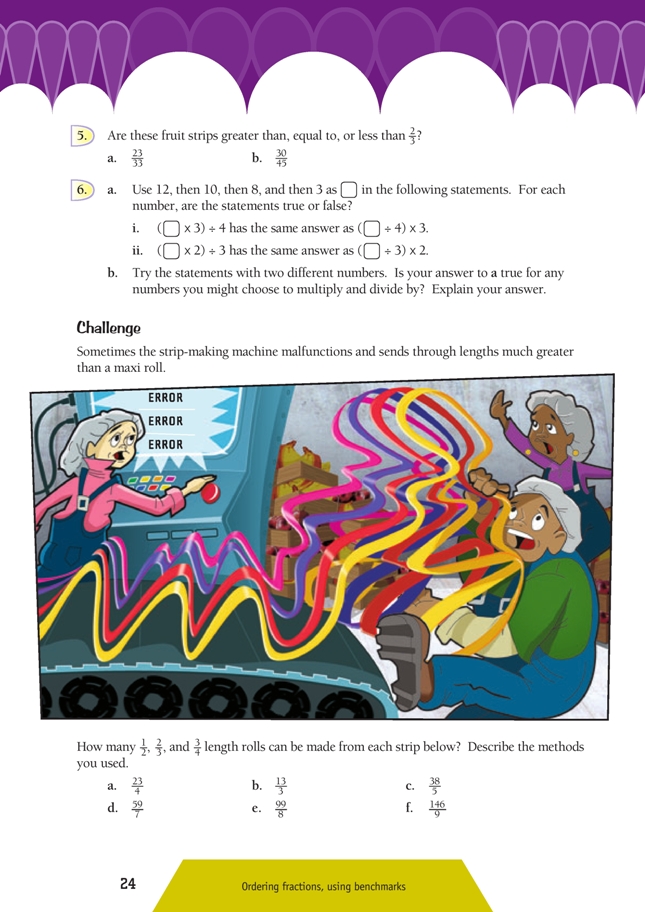This is a level 4 number activity from the Figure It Out series. It relates to Stage 7 of the Number Framework.
A PDF of the student activity is included.
Click on the image to enlarge it. Click again to close. Download PDF (1358 KB)
order fractions using benchmarks
find equivalent fractions
Number Framework Links
Use this activity to encourage transition from advanced additive strategies (stage 6) to advanced multiplicative strategies (stage 7).
- Fraction Strips (optional)
- FIO, Levels 3-4, Multiplicative Thinking, Rolling Up!, pages 22-24
- A calculator (optional, for the Challenge)
The problems in this activity look at ways to tell if one fraction is larger or smaller than another fraction. Many misconceptions about fractions come from generalisations about whole numbers.
For example, a student might say that 3/4 is larger than 2/3 because 3 is larger than 2. This is a correct answer for the wrong reason.
Questions 1 and 2 are aimed at establishing students’ knowledge about the proximity of fractions to 1/2. One-half is a key “benchmark” fraction for students. Begin by considering what fractions equal . “Splitting” is a useful approach. For example, if students split a strip into 2 equal parts
and then split one of those parts into 3, they show that 1/2 = 3/6:
Students need to be able to make the generalisation that for all fractions equal to , twice the numerator (top number) equals the denominator (bottom number) and half the denominator equals the numerator. For example:
This knowledge allows the students to compare the strategies used by Rolf, Moana, and Jake to tell if a fraction is greater or less than 1/2. All three strategies work, but Rolf’s and Jake’s methods are more efficient for fractions that have large numbers for the numerator and denominator. For example, to check 47/92, Moana must make up a list of nearly 50 fractions. Rolf doubles 47 to get 94. 94 is greater than 92, so the fraction is larger than 1/2 as 47/94 equals 1/2.
Algebraically, this means that the fraction a/b is greater than 1/2 if 2a > b or b/2 < a.
In questions 3 and 4, the students need to generalise these ideas so that they can be applied to the fractions 3/4 and 2/3. Start by generating some fractions equivalent to and so that the students can look for common number properties.
Using splitting, 1/3 split into equal pieces gives 2/6, so 2/3 is equal to 4/6:
So the fractions 4/6, 6/9, 8/12, … are all equivalent to 2/3. The number properties common to them can be expressed algebraically in these ways:
• Half the numerator multiplied by 3 equals the denominator; that is, given a/b = 2/3, then 3(a/2) = b or 3a/2 = b.
• One-third of the denominator multiplied by 2 equals the numerator; that is, if a/b = 2/3, then 2b/3 = a.
To test if a fraction is equal to 2/3, Piripi and Marissa create an equivalent fraction against which to compare it. Piripi operates on the denominator and Marissa on the numerator.
To test 7/12, Piripi makes a fraction equivalent to 2/3 with 12 as the denominator; that is, 2/3 = 8/12. 7/12 < 8/12, so it is smaller than 2/3.
Marissa makes a fraction equivalent to 2/3 with 7 as the numerator; that is, 7 ÷ 2 = 3 1/2 and 3 1/2 x 3 = 10 1/2, so 7/10 1/2 = 2/3 and 7/12 < 7/10 1/2, so 7/12 is smaller than 2/3.
Question 6 is about whether the order of multiplication and division operations makes any difference to the result. It doesn’t. For example, 12 x 3 ÷ 4 and 12 ÷ 4 x 3 give the same result (9). Note that 9 is 3/4 of 12.
So, to find a fraction (a/b) of a number n, you can either work out n ÷ b x a =or n x a ÷ b =. In any given situation, it is likely that one of these orders will be more convenient than the other, so students need to understand that they can choose freely.
The Challenge section is about measuring one fraction by another, which is equivalent to division by a fraction. This is a very difficult concept even for students who are at the advanced proportional stage.
For example, to find how many 2/3 rolls are in 13/3:
2 goes into 13 six times, so with 1 remainder, you can get 6 1/2 two-third rolls in . This is equivalent to 13/3 ÷ 2/3 = 6 1/2.
To find how many 3/4 lengths fit into 13/3 is more difficult because the fractions have different denominators (the units are different). One strategy is to rename each length in the same unit:
Splitting each third into 4 equal parts gives 52/12.
Splitting each quarter into 3 equal pieces gives 9/12 for 3/4.
It is now possible to measure 52/12 with 9/12. 52 ÷ 9 = 5 7/9, which is how many length rolls can be made from a 13/3 roll. This could be written as: 13/3 ÷ 3/4 = 52/12 ÷ 9/12 = 5 7/9.
Answers to Activity
1. a. Yes. (4/8 = 1/2, so 3/8 is less than 1/2)
b. No. ( (1 1/2) / 3 = 1/2, so 2/3 is more than 1/2)
c. No. (5/10 = 1/2, so 6/10 is more than 1/2)
d. No. ( (3 1/2) /7 = 1/2, so 4/7 is more than 1/2)
e. Yes. ( (5 1/2)/11 = 1/2, so 5/11 is less than 1/2)
f. No. ( (6 1/2)/13= 1/2, so 7/13 is more than 1/2)
g. Yes. ( (14 1/2)/ 29 = 1/2, so 14/29 is less than 1/2)
h. No. (49/98 = 1/2)
2. a. Rolf: The double the numerator method works and is easy to use.
b. Moana: Going through the list of equivalent fractions is slow and cumbersome. With odd denominators, a different check is needed, such as method a.
c. Jake: The halve the denominator method works and is easy to use.
3. a. i. Yes. ( 9/12 = 3/4, so 10/12 is more than 3/4.)
ii. No. (75/100 = 3/4, so 74/100 is less than 3/4.)
iii. Yes. (24/32 = 3/4)
iv. No. (11/45 is less than 1/4, so 33/45 is less than 3/4.)
b. Answers will vary, but these methods will work:
i. Divide the denominator by 4, then multiply the result by 3. If the answer
is less than the numerator, then the fraction is greater than 3/4.
ii. Divide the numerator by 3 and multiply the result by 4. If the answer is greater
than the denominator, then the fraction is greater than 3/4.
4. Piripi:
7/12: 12 ÷ 3 = 4, 4 x 2 = 8. 8/12 = 2/3, so 7/12 is less than 2/3.
10/14: 14 ÷ 3 = 4 2/3, 4 2/3 x 2 = 9 1/3. (9 1/3)/14 = 2/3, so 10/14 is greater than 2/3.
Marissa:
7/12 : 7 ÷ 2 = 3 1/2, 3 1/2 x 3 = 10 1/2. (7/ 10 1/2) = 2/3, so 7/12 is less than 2/3.
10/14: 10 ÷ 2 = 5, 5 x 3 = 15. 10/15 = 2/3, so 10/14 is greater than 2/3.
5. a. Greater than. 22/33 = 2/3, so 23/33 is greater than 2/3.
b. Equal to. (Both 30 and 45 divide by 15. That is, Piripi’s and Marissa’s methods both give 30/45 = 2/3.)
6. a. i.–ii. The statements are true for all four numbers. (For example, 12 x 3 ÷ 4 = 36 ÷ 4 = 9, and 12 ÷ 4 x 3 = 3 x 3 = 9; 12 x 2 ÷ 3 = 24 ÷ 3 = 8, and 12 ÷ 3 x 2 = 4 x 2 = 8.)
b. Yes, the statements work for any numbers. Changing the order of the multiplication and division does not change the answer.
Challenge
Possible methods include:
• using equivalent fractions and dividing
• converting all the fractions to decimals.
a. 1/2 length rolls: 11. 23/4 = (11 1/2)/2, so 11 half-length rolls can be made.
2/3 length rolls: 8. 2/3 = 8/12 and 23/4 = 69/12; 69 ÷ 8 = 8 r5, so 8 two-third-length rolls are possible.
3/4 length rolls: 7. 23/4 ÷ 3/4 = 23 ÷ 3 = 7 r2, so 7 three-quarter-length rolls can be made.
b. 1/2 length rolls: 8.13/3 = 4 . 4 ÷ 1/2 = 8, so 8 half-length rolls can be made.
2/3 length rolls: 6. 13/3 ÷ 2/3 = 6 1/2, so 6 two-third-length rolls can be made.
3/4 length rolls: 5. 13/3= 4/3 . There are 16 quarters in 4 (16/4 = 4), so 5 lots of 3/4 can be made from 4 lengths (5 x 3 = 15). The extra 1/4 + 1/3 is less than 3/4.
c. 1/2 length rolls: 15. 38/5 = 7 3/5. From 7 1/2, 15 half-length rolls can be made.
2/3 length rolls: 11. 2/3 =10/15 and 38/5 = 114/5.
114 ÷ 10 = 11.4, so 11 two-third-length rolls can be made.
3/4 length rolls: 10. 7 1/2 = 15/2 = 30/4, so 10 lengths of 3/4can be made.
d. 1/2 length rolls: 16. 59/7 is 8 7/9, which is just less than 8 1/2. From 8 1/2, 17 half-length rolls can be made, so from 8 3/7, 16 half-length rolls can be
made.
2/3 length rolls: 12. Based on 8 3/7 being just less than 8 1/2: 2/3= 4/6 and 8 1/2= 17/2 = 51/6. 51 ÷ 4 = 12 3/4, so 12 two-third-length rolls can be made.
3/4 length rolls: 11. Based on 8 3/7 being just less than 8 1/2: 8 1/2 = 34/4, 34 ÷ 3 = 11 1/3, so 11 threequarter- length rolls can be made.
e. 1/2 length rolls: 24. 99/8 = 12 3/8. 12 x 2 = 24
2/3 length rolls: 18. 99/8 = 12 3/8. (3/8 is less than 2/3.)
12 = 36/3; 36 ÷ 2 = 18.
3/4 length rolls: 16. 99/8 = 12 3/8. (3/8 is less than 3/4.)
12 = 48/4. 48 ÷ 3 = 16.
f. 1/2 length rolls: 32. 146/9 = 16 2/9, so 32 half-length rolls can be made.
2/3 length rolls: 24. 2/3 = 6/9; 146/9 ÷ 6/9 = 24 1/3 (or 146 ÷ 6 = 24 ), so 24 two-third-length rolls can be made.
3/4 length rolls: 21. 146/9 = 16 2/9. From 15, 20 three-quarter-length rolls can be made.(15 = 60/4. 60/4 ÷ 3/4 = 20) From the remaining 1 2/9, one extra 3/4 can be made, making a total of 21 strips.






